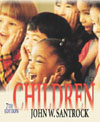John W. Santrock,
University of Texas, Dallas
| anger cry | a cry similar to the basic cry, with more excess air forced through the vocal chords (associated with exasperation or rage).
(See 221)
|
 |
 |
 |
| attachment | a close emotional bond between an infant and a caregiver.
(See 231)
|
 |
 |
 |
| basic cry | a rhythmic pattern usually consisting of a cry, a briefer silence, a shorter inspiratory whistle that is higher pitched than the main cry, and then a brief rest before the next cry.
(See 221)
|
 |
 |
 |
| difficult child | a child who tends to react negatively and cry frequently, who engages in irregular daily routines, and who is slow to accept new experiences.
(See 225)
|
 |
 |
 |
| easy child | a child who is generally in a positive mood, who quickly establishes regular routines in infancy, and who adapts easily to new experiences.
(See 225)
|
 |
 |
 |
| emotion | feeling, or affect, that can involve physiological arousal (a fast heartbeat, for example), conscious experience (thinking about being in love with someone, for example), and behavioral expression (a smile or grimace, for example).
(See 220)
|
 |
 |
 |
| emotional regulation | consists of effectively managing arousal to adapt and reach a goal.
(See 223)
|
 |
 |
 |
| insecure avoidant babies | show insecurity by avoiding the mother.
(See 233)
|
 |
 |
 |
| insecure disorganized babies | show insecurity by being disorganized and disoriented.
(See 233)
|
 |
 |
 |
| insecure resistant babies | may cling to the caregiver, then resist her by fighting against the closeness, perhaps by kicking or pushing away.
(See 233)
|
 |
 |
 |
| Maximally Discriminative Facial Movement Coding System (MAX) | Izard's system of coding infants' facial expressions related to emotions. Using MAX, coders watch slow-motion and stop-action videotapes of infants' facial reactions to stimuli.
(See 221)
|
 |
 |
 |
| pain cry | a sudden appearance of loud crying without preliminary moaning and a long initial cry followed by an extended period of breath holding.
(See 221)
|
 |
 |
 |
| reciprocal socialization | socialization that is bidirectional; children socialize parents, just as parents socialize children.
(See 238)
|
 |
 |
 |
| reflexive smile | a smile that does not occur in response to external stimuli. It happens during the month after birth, usually during irregular patterns of sleep, not when the infant is in an alert state.
(See 222)
|
 |
 |
 |
| scaffolding | parental behavior that supports children's efforts, allowing them to be more skillful than they would be if they relied only on their own abilities.
(See 238)
|
 |
 |
 |
| secure attachment | the infant uses a caregiver as a secure base from which to explore the environment. Ainsworth believes that secure attachment in the first year of life provides an important foundation for psychological development later in life.
(See 233)
|
 |
 |
 |
| separation anxiety | the fear and distress of being left by the caregiver.
(See 223)
|
 |
 |
 |
| slow-to-warm-up child | a child who has a low activity level, is somewhat negative, shows low adaptability, and displays a low intensity of mood.
(See 225)
|
 |
 |
 |
| social referencing | involves "reading" emotional cues in others to help determine how to act in a particular situation.
(See 223)
|
 |
 |
 |
| social smile | a smile in response to an external stimulus, which, early in development, typically is in response to a face.
(See 222)
|
 |
 |
 |
| stranger anxiety | an infant's fear and wariness of strangers; it tends to appear in the second half of the first year of life.
(See 223)
|
 |
 |
 |
| Strange Situation | an observational measure of infant attachment that requires the infant to move through a series of introductions, separations, and reunions with the caregiver and an adult stranger in a prescribed order.
(See 233)
|
 |
 |
 |
| temperament | an individual's behavioral style and characteristic way of emotional response.
(See 225)
|



 2003 McGraw-Hill Higher Education
2003 McGraw-Hill Higher Education

 2003 McGraw-Hill Higher Education
2003 McGraw-Hill Higher Education